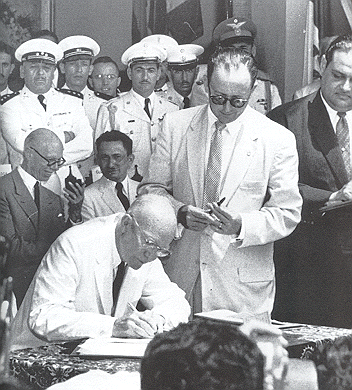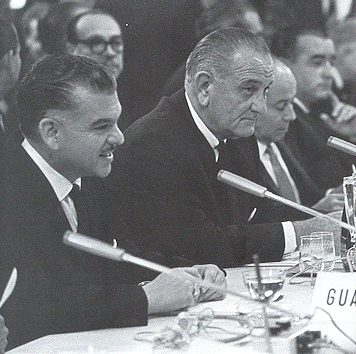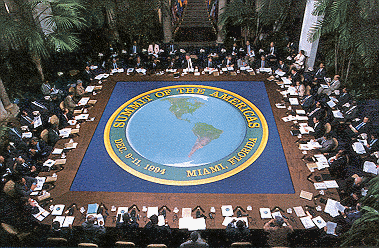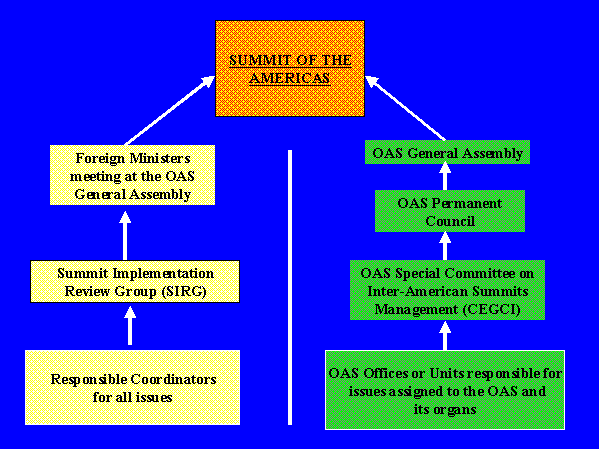|
The Summit Process I. Introduction The Summit of the Americas process ("Summit process") is an institutionalized set of meetings at the highest level of government decision-making in the Western Hemisphere. The purpose of the meetings ("Summits") is to discuss common issues and seek solutions to problems shared by all the countries in the Americas, be they economic, social or political in nature. The process has both political principles and institutional elements. The political principles of the process dictate that the process shall include the 34 democratic nations of the Americas, who operate with free market economies, conduct multilateral international negotiations and who reach decisions by consensus. The institutional elements are the mechanisms and bodies in charge of the process, decision-making, implementation and follow-up. This section outlines the events of the Summit process from 1994 to 2002, from the preparations for the First (Miami) Summit of the Americas to the Third Summit of the Americas, held in Quebec City, Canada. It also provides an overview of the various institutional bodies and briefly describes the role of the OAS in the Summit process. II. Brief History of the Modern Summit Process Early Summits Two Presidential Summits were held in the years prior to Miami. The first, in July of 1956, brought the leaders of 19 countries together under the auspices of the Organization of American States at Panama City, Panama. It was hoped the Summit would invigorate the OAS as a driving force for economic and social development in the Americas. The representatives meeting in Panama undertook the following action:
The second Summit, held in Punta del Este, Uruguay, in April of 1967, also
brought together 19 Hemispheric leaders, plus a representative from Haiti.
Unfortunately, the 1967 vision for hemispheric free trade south of the United States was not achieved, and the development plan was never fully implemented. Twenty seven years later, in Miami, auspicious historic conditions existed for the Governments of the Americas to once again meet. The end of the Cold War brought forth a new era of consensus and understanding at a time when important problems, now less ideological and more concrete, continued to confront the peoples of the continent. The Modern Summit Process Reorganizing Inter-American relations, by adapting debates and procedures to the new political, economic and social conditions of the world and the region, was one of the fundamental objectives of the modern hemispheric Summit process initiated in Miami in 1994. The existence of new players, points of reference as well as a common understanding on political and economic principles based on the tenets of democracy and market economy made possible unprecedented political cooperation and economic integration in the Hemisphere, from Canada to Argentina. The Heads of State and Government of the Americas, the architects of this new system, decided to meet on a regular basis in order to define the fundamental precepts of the new Hemispheric agenda. This decision to institutionalize the meetings led to the notion of a "Summit process", where experiences are accumulated, a common language is forged and mandates for collective action are programmed, systematizing the new theoretical and practical references in hemispheric relations. This institutionalization had been lacking during the cold war summits which were organized on an ad hoc basis. The new era in hemispheric relations is characterized by the revitalization of multilateralism which acts as a catalyst for the modernization of the various institutions of the Inter-American system, including the principal political forum, the Organization of American States. Preparatory Stage of the Summit of the Americas (1994): In January of 1994, President Clinton proposed to organize a Presidential Summit in the United States, in order to discuss the following matters:
In March of the same year, US Vice-President Al Gore, on a visit to Mexico, announced President Clinton’s desire to host a Summit in Miami in December of 1994. The following issues were placed on the table for discussion at Miami:
During the first semester of 1994, the United States undertook bilateral consultations in order to develop a Declaration and a Plan of Action for the Summit. During the following months, inter-governmental meetings were held and many international organizations contributed documents and suggestions that were considered by the organizers and participants of the Summit. In the case of the OAS, the Permanent Council, jointly with the Secretary General, prepared a paper outlining possible contributions of the OAS to the Summit of the Americas. While inter-governmental consultations in preparation for the Summit continued, the Rio Group met in October of 1994. The Group's members agreed to present a multilateral proposal, achieved by consensus, for the Miami Plan of Action. This led the coordinators of the 34 OAS member States to meet, in late November at Airlie House, Virginia, in order to agree upon the final documents. It is important to highlight the significance of this meeting as it was the first time in the Summit preparations that representatives of the 34 countries sat at the same table in order to discuss and negotiate, under equal conditions, the commitments of the Plan of Action that would be approved by all the participant Summit countries. First Summit of the Americas, Miami The Summit of the Americas took place in Miami, December 9 to 11, 1994. The meeting produced a Declaration of Principles and a Plan of Action signed by all 34 Heads of State and Government in attendance. It is important to note that it was the first Summit were all of the leaders were democratically elected, and the first Summit to include Canada, and the island States of the Caribbean.
Negotiations for the FTAA One of the most important initiatives to emerge from the Miami Summit was the agreement to work towards creating a Free Trade Area of the Americas ("FTAA"). The FTAA was to provide free market access for goods and services to the entire continent. It was decided that negotiations for an FTAA should conclude no later than the year 2005. In order to realize this ambitious trade area, a Tripartite Committee, composed of the Inter-American Development Bank, the Organization of American States, and the United Nations' Economic Commission for Latin America and the Caribbean, was created in order to provide technical support and help prepare background documents required for the negotiation process. Summit of the Americas on Sustainable Development: Another important initiative from the Miami Summit was the inclusion of a proposal from the President of Bolivia, Gonzálo Sánchez de Lozada, to call a specialized Summit on Sustainable Development to be held in Santa Cruz de la Sierra, Bolivia in 1996. The objectives of the specialized Summit were to establish a common vision for the future according to the concepts of sustainable development and to ratify the principles subscribed to at the 1992 Earth Summit held in Rio de Janeiro, Brazil. The long and complex multilateral negotiations included input from an important contingent of Civil Society organizations. These, under the leadership of a Technical Committee, produced a proposal for sustainable development which was presented to the OAS member States for consideration and discussion. The proposal was the fruit of a series of broad national and subregional consultations. It is important to highlight both the participation of the OAS and Civil Society in the preparatory work for the Bolivian Summit. The OAS Working Group in charge of preparing the documents for the Summit, held, for the first time in the Organization, a working session where civil society organizations were invited to participate Summit's preparatory process. The negotiations over the eventual Declaration and Plan of Action of Santa Cruz were complex due to the very different positions held concerning the concept of Sustainable Development. On one hand, some countries insisted on the importance of the environment as an independent issue. Other countries suggested incorporating the environmental dimension within a vision for integral development. Reconciliation of these two points of view through consensus produced the Declaration and the Plan of Action of Santa Cruz on December 7 and 8, 1996. The Plan of Action included initiatives in the following areas: Health and Education; Sustainable Agriculture and Forestry; Sustainable Cities and Communities; Water Resources and Coastal Areas; and Energy and Minerals. The general consensus on the concept of including economic, social and environmental elements within an understanding of sustainable development was perhaps the most important achievement of the Bolivian Summit. Consensus was also reached on other issues such as a financial resources, technology transfers, division of responsibilities, cooperation and Biodiversity among others. Second Summit of the Americas: Unlike the First (Miami) Summit of the Americas, which was convoked by President Clinton to engage with the countries of Latin America over the many issues of the Hemisphere, the decision to hold a second Summit of the Americas was jointly made by all the Heads of State of the Americas. The Santiago Summit was jointly prepared, discussed and approved by all the countries. It is important to emphasize the active participation of sub-regional organizations such as that of the Caribbean and the Rio Group. The negotiations for a Declaration and a Plan of Action were carried out in the Summit Implementation Review Group ("SIRG" - see below for explanation) meetings with the support of the Organization of American States, the Inter-American Development Bank, and the Economic Commission for Latin America and the Caribbean. More emphasis was given to social policies and essential matters of the Inter-American agenda, such as how to consolidate and improve the quality of democracy, respect for human rights and the path to a Free Trade Area of the Americas, were also discussed. The result of these deliberations produced a Declaration and Plan of Action of Santiago which contained 27 initiatives, each reflecting the concerns of the different countries. The initiatives were grouped into the following subjects:
One of the initiatives in the "Summit of the Americas Follow-Up" section of the Plan of Action assigned the OAS responsibility to keep the "institutional memory of the [Summit] process" and for providing technical support to the Summit Implementation Review Group (SIRG) III. Summit of the Americas Follow-Up Mechanisms: One of the most significant achievements of the Second Summit of the Americas, is that it laid the groundwork for the institutionalization of the Summit as a process. Among other things, the follow-up section of the Santiago Plan of Action committed the Heads of State and Government to continue to meet periodically to "deepen cooperation and understanding among the countries of the Americas". Between these Summit meetings, follow-up work is done by the Summit Implementation Review Group. In March 1995, the United States Government created the Summit Implementation Review Group, with the purpose of coordinating and implementing the mandates of the Miami Plan of Action. Initially, the SIRG was composed of members representing the various sub-regions of the Hemisphere. Subsequently, the Group was composed of representatives from all of the countries of the Hemisphere. From its conception until March of 1997, the Group was Chaired by the United States of America because it had been the host of the Miami Summit. After March of 1997, Chile assumed the healm for hosting the Second Summit of the Americas; Canada, in turn, will become the Chair when it hosts the Third Summit of the Americas in the year 2000 or 2001. These three countries form what is commonly known as the SIRG "troika", and are responsible for coordinating the agenda and activities of the Group. The Summit Implementation Review Group, meets on a periodic basis; holding approximately 4 regular meetings, plus one ministerial-level meeting each year. Representatives to the SIRG are known as National Coordinators (the current list of National Coordinators is available here). A list of the SIRG meeting, along with the documentation presented at those meetings is available here. The SIRG is responsible for reporting annually on the progress achieved in the fulfillment of the Plan of Action to the Foreign Ministers. These in turn review the information on the occasion of the Regular Session of the OAS General Assembly. Under the guidance of the Foreign Ministers, the SIRG is responsible for making preparations for subsequent Summits, bearing in mind the contributions of the pertinent organs of the OAS, the IDB, ECLAC and PAHO, as well as other international organizations involved. Senior representatives of the Organization of American States (OAS), the Inter-American Development Bank (IDB), the Pan American Health Organization (PAHO), the United Nations Economic Commission on Latin America and the Caribbean (ECLAC), and the World Bank are be invited to support the Governments in the SIRG in order to follow up on the commitments of the Summit and to achieve greater coordination and effectiveness of these institutions in performing this task. In addition to the SIRG meetings, there is a parallel multilateral Summit follow-up mechanism within the political structure of the Organization of American States: the Special Committee on Inter-American Summits Management ("CEGCI", for the Spanish Comisión Especial de Gestión de Cumbres Interamericanas"). This Committee of the Permanent Council, hears reports from the various Units, and Offices of the Organization charged with implementing specific Summit items. It occasionally requests on the activities of other international organizations. The Committee has a reporting responsibility to the OAS General Assembly, through the Permanent Council. The CEGCI also serves as a forum for civil society participation in the Summit process. Documents of the Special Commission are available here. The picture below illustrates the two track multilateral follow-up mechanism of the Summit process.
c. National Follow-up Mechanisms: Implementation of the various Summit mandates from Miami to Quebec City, implies work both at the international-multilateral level as well as at the national level. As outlined above, multilateral action is reviewed both by the SIRG and the CEGCI. National programs are undertaken and reviewed individually by each country; information is provided to the SIRG. Government ministries or departments throughout the hemisphere with their own Internet homepages are listed here. d. International Organizations: The Santiago Plan of Action states that international organizations, in accordance with Summit decisions, will have responsibilities in implementing the Summit process and the mandates of the process, as appropriate. In addition to the OAS, there are four principal multilateral organizations involved in implementing specific Summit issues. The organizations in question are the Economic Commission for Latin America and the Caribbean, the Inter-American Development Bank, the Pan American health Organization and the World Bank. Other international organizations, from the family of United Nations organizations, such as the United Nations Educational, Scientific and Cultural Organization, the United Nations Environment Programme, the International Maritime Organization, the International Labour Organization, the International Telecommunications Union, and the World Trade Organization play smaller supporting roles in summit implementation. The list of Responsible Coordinators also indicates which international organization is responsible, or jointly responsible, for the implementation of a specific Summit mandate. IV. The OAS in the Summit Process: The OAS did not participate in the preparation of the Miami Summit documents. On the occasion of the official visit of US Vice President, Al Gore, to the Organization on November 17, 1994, Secretary General César Gaviria, highlighted the importance of strengthening the Inter-American System and multilateralism. Mr. Gaviria congratulated President Clinton for his initiative convoking all the countries of the Hemisphere and offered the offices of the OAS to implement mandates from the Summit. The Secretary General attended the (Miami) Summit of the Americas and spoke about the importance of the Summit for Inter-American relations and for building confidence among the countries and institutions of the Inter-American System. The Secretary General explained his vision for the OAS, where is would be reformed in order to adapt itself to the "new agenda and to the priorities set " by the dignitaries in the Summit of the Americas Declaration and Plan of Action, in order to be able to fulfill the tasks assigned. Speech At the Miami Summit, the Heads of State and Government assigned mandates to the OAS in areas where very different positions existed among the participants. These mandates included drugs, corruption, terrorism, hemispheric security, and sustainable development and environment. The OAS accepted these mandates and incorporated them into its agenda on a priority basis. The Organization has taken part in the implementation of 13 of the 23 initiatives agreed upon at Miami. A detailed description of the actions of the OAS in the implementation of the Plan of Action can be found in the "Report of the President of the Special Committee on Inter-American Summit Management on the actions of the OAS regarding the implementation and support of the the mandates of the Summit of the Americas" of December 1997. The Secretary General of the OAS presented a detailed report on the progress made in the implementation of the Santa Cruz Plan of Action to the Heads of State and Government meeting at the Second Summit of the Americas. Finally, The OAS participated actively in the preparatory work for the Second Summit, providing technical support and organizing preparatory meetings in different fields such as education, science and technology, public participation, and drugs among others. The Office of Summit Follow-Up As mentioned above, aside from important mandates in such varied fields as drugs, human rights, and telecommunications, the OAS General Secretariat has been given responsibility for operating as a record-keeping mechanism, "the institutional memory of the [Summit] process and for providing technical support to the SIRG". This responsibility is fulfilled by the Office of Summit Follow-Up, created in July of 1998, shortly after the Second Summit of the Americas. This Internet homepage is the repository of this information and is intended for both official use, by the member States of the OAS and the Summit Process, and by the public at-large. * The 34 Summit of the Americas nations are the same as the 34 member States of the Organization of American States (the 35th OAS member State, Cuba, has been suspended since 1962). The countries are: Antigua and Barbuda, Argentina, The Bahamas, Barbados, Belize, Bolivia, Brazil, Canada, Chile, Colombia, Costa Rica, Dominica, Dominican Republic, Ecuador, El Salvador, Granada, Guatemala, Guyana, Haiti, Honduras, Jamaica, Mexico, Nicaragua, Panama, Paraguay, Peru, Saint Kitts and Nevis, Saint Lucia, Saint Vincent and the Grenadines, Suriname, Trinidad and Tobago, United States, Uruguay, and Venezuela. (Note: The photographs and paragraphs on the 1959 and 1967 Summits are from "Building a Partnership for Prosperity", the White House Report on the Summit of the Americas.) |



